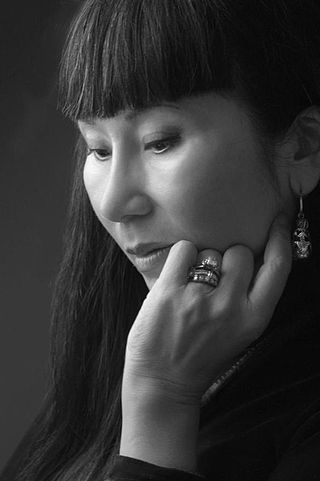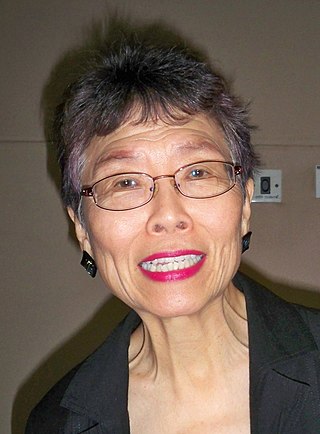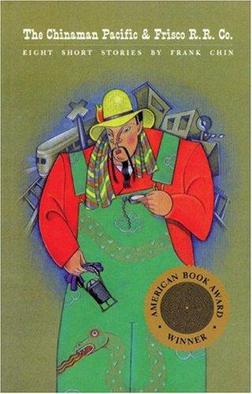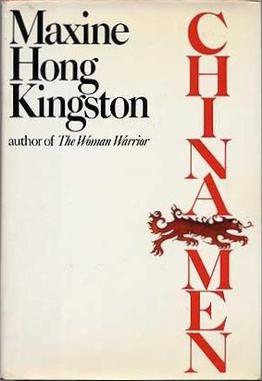
Amy Ruth Tan is an American author of Chinese heritage, best known for the novel The Joy Luck Club (1989), which was adapted into a 1993 film. She is also known for other novels, short story collections, children's books, and a memoir.

Hua Mulan is a legendary folk heroine from the Northern and Southern dynasties era of Chinese history.

Maxine Hong Kingston is an American novelist. She is a Professor Emerita at the University of California, Berkeley, where she graduated with a BA in English in 1962. Kingston has written three novels and several works of non-fiction about the experiences of Chinese Americans.

Jade Snow Wong was a Chinese American ceramic artist and author of two memoirs. She was given the English name of Constance, also being known as Connie Wong Ong.

Frank Chin is an American author and playwright. He is considered to be one of the pioneers of Asian-American theatre.

Tsai Chin is a Chinese actress, singer, director, teacher, and author best known in the United States for her role as Auntie Lindo in the film The Joy Luck Club.

Shirley Geok-lin Lim is an American writer of poetry, fiction, and criticism. She was both the first woman and the first Asian person to be awarded Commonwealth Poetry Prize for her first poetry collection, Crossing The Peninsula, which she published in 1980. In 1997, she received the American Book Award for her memoir, Among the White Moon Faces.
Eighteen Songs of a Nomad Flute are a series of Chinese songs and poems about the life of Han Dynasty poet Cai Wenji, the songs were composed by Liu Shang, a poet of the middle Tang Dynasty. Later Emperor Gaozong of Song (1107–1187) commissioned a handscroll with the songs accompanied by 18 painted scenes.
Ronyoung Kim, aka Kim Ronyoung, was the pen name of Gloria Hahn, a Korean American writer. She was born and raised to Korean immigrants in Los Angeles's Koreatown and died not long after finishing Clay Walls (1987), a Pulitzer Prize-nominated novel about a Korean family that leaves Japanese-occupied Korea in the 1920s to live in the United States that was "the first major novel to illustrate the experiences of Korean immigrants and Korean Americans in the United States".

Eat a Bowl of Tea is a 1961 novel by American writer Louis Chu. It was the first Chinese American novel set in Chinese America. Because of its portrayal of the "bachelor society" in New York's Chinatown after World War II, it has become an important work in Asian American studies. It has been cited as an influence by such authors as Frank Chin and Maxine Hong Kingston. It was made into a film of the same name by Wayne Wang in 1989.
Hisaye Yamamoto was an American author known for the short story collection Seventeen Syllables and Other Stories, first published in 1988. Her work confronts issues of the Japanese immigrant experience in America, the disconnect between first and second-generation immigrants, as well as the difficult role of women in society.

Diana Chang was a Chinese American novelist and poet. She is best known for her novel The Frontiers of Love, one of the earliest novels by an Asian American woman. She is considered to be the first American-born Chinese to publish a novel in the United States.

Tripmaster Monkey: His Fake Book is the third book written by Maxine Hong Kingston, and was published in 1989. The story follows Wittman Ah Sing, an American graduate of University of California, Berkeley of Chinese ancestry in his adventures about San Francisco during the 1960s. Heavily influenced by the Beat movement, and exhibiting many prototypical features of postmodernism, the book retains numerous themes, such as ethnicity and prejudice, addressed in Kingston's other works. The novel is rampant with allusions to pop-culture and literature, especially the 16th century Chinese novel Journey to the West.
Chinese American literature is the body of literature produced in the United States by writers of Chinese descent. The genre began in the 19th century and flowered in the 20th with such authors as Sui Sin Far, Frank Chin, Maxine Hong Kingston, and Amy Tan.

Asian American literature is the body of literature produced in the United States by writers of Asian descent. Asian American literature became a category during the 1970s but didn't see a direct impact in viewership until later in the 1970s. Perhaps the earliest references to Asian American literature appeared with David Hsin-fu Wand's Asian American Heritage: An Anthology of Prose and Poetry, published in 1974. One of the earlier pieces of Asian American literature produced by Combined Asian American Resources Project (CARP) was Aiiieeeee! An Anthology of Asian-American Writers (1974). This anthology collected staples of long-forgotten Asian American literature and criticized the lack of visibility of this literature. This anthology brought to light the necessity of visibility and criticism of Asian American literature; with visibility came recognition of new literature. Elaine Kim's seminal book of criticism, Asian American Literature: An Introduction to the Writings and Their Social Context, was published in 1982 and was the first critical book on the topic.
Nora Okja Keller is a Korean American author. Her 1997 breakthrough work of fiction, Comfort Woman, and her second book (2002), Fox Girl, focus on multigenerational trauma resulting from Korean women's experiences as sex slaves, euphemistically called comfort women, for Japanese and American troops during World War II and the ongoing Korean War.

Aiiieeeee! An Anthology of Asian-American Writers is a 1974 anthology by Frank Chin, Jeffery Paul Chan, Lawson Fusao Inada, and Shawn Wong, members of the Combined Asian American Resources Project (CARP). It helped establish Asian American literature as a field by recovering and collecting representative selections from Chinese, Japanese, and Filipino Americans from the past fifty years—many of whom had been mostly forgotten. This pan-Asian anthology included selections from Carlos Bulosan, Diana Chang, Louis Chu, Momoko Iko, Wallace Lin, Toshio Mori, John Okada, Oscar Peñaranda, Sam Tagatac, Hisaye Yamamoto, Wakako Yamauchi, many of whom are now staples in Asian American literature courses. Because of this anthology and the work of CARP, many of these authors have been republished; at that time, however, they received little attention from publishers and critics because they didn't subscribe to popular stereotypes but depicted what Elaine H. Kim calls the "unstereotyped aspects of Asian American experience". The "aiiieeeee!" of the title comes from a stereotypical expression used by Asian characters in old movies, radio and television shows, comic books, etc. These same stereotypes affected the anthology itself: when the editors tried to find a publisher, they had to turn to a historically African-American press because, as Chin states:
The blacks were the first to take us seriously and sustained the spirit of many Asian American writers.... [I]t wasn't surprising to us that Howard University Press understood us and set out to publish our book with their first list. They liked our English we spoke [sic] and didn't accuse us of unwholesome literary devices.

The Chinaman Pacific and Frisco R.R. Co. is a 1988 short-story collection by Frank Chin that collects many of the short stories he had published in the 1970s. It won the American Book Award. The collection deals with Chinese-American history by recalling the work of early Chinese immigrants in such jobs as "coolie, railworker and launderer".

China Men is a 1980 collection of "stories" by Maxine Hong Kingston, some true and some fictional. It is a sequel to The Woman Warrior with a focus on the history of the men in Kingston's family. It won the 1981 National Book Award for Nonfiction.

Donald Duk is a coming-of-age novel written by Frank Chin, first published in February 1991. It is about an eleven-year-old boy turning twelve, completing a cycle of the Chinese zodiac, in San Francisco, and his struggles juggling cultures and growing into his name.



















